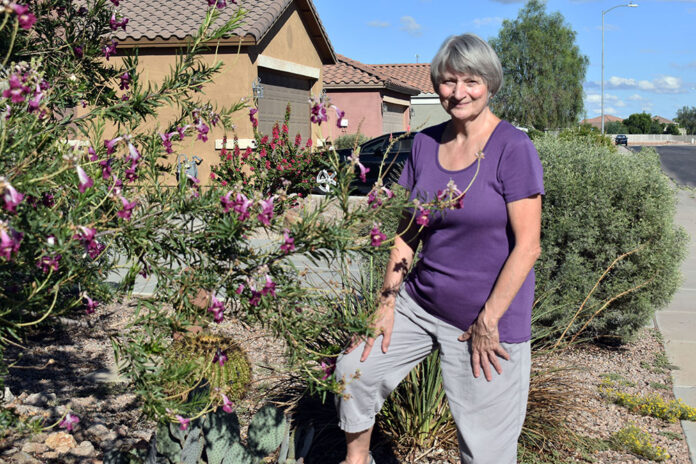By Trudy Fuller
There is nothing more humbling than gardening on the low desert of Arizona. It has been five years since we moved to Maricopa from the Southeast. Greeting us in the Maricopa backyard were waist-high weeds on steroids and struggling trees and bushes.
Things have gradually progressed since then. Two important things were responsible for a very modest turnaround. One was by chance finding a copy of the magazine called Landscape Plants for the Arizona Desert: A Guide to Growing More Than 200 Low-Water-Use Plants compiled by the Arizona Municipal Water Users Association (also available online at AMWUA.org/Plants). The other was finding and enrolling in the Garden and Landscape Short Course at the Maricopa Agricultural Center here in Maricopa.
One low-water-use native tree included in the previously mentioned Landscape Plants for the Arizona Desert is the heat-loving desert willow known in the botanical world as Chilopsis linearis. You may think planting this fast-growing, multi-stemmed tree means you don’t have to water at all. These trees originated on the banks of washes, creeks and streams, so there was at least occasional water available in their natural habitat.
Due to the long-standing drought here on the low desert in the city of Maricopa and Pinal County, one definitely needs to water deeply during the intense heat of summer at least once a week. In addition to having the characteristic of a sprawling, large bush, the desert willow can also be started from a cutting as a single-stemmed tree. When the single-stemmed tree is young, allow some of the lower branches to remain on the trunk for a couple of years, as this will encourage the trunk to grow thicker.
Pruning needs to be done in the winter after the leaves have dropped. Here in Maricopa, this leaf drop occurs after our first period of cold weather, usually from mid- November until after the new year. Those who maintain swimming pools need to be aware of this phenomenon. The desert willow delivers filtered shade as opposed to dense shade, so wind usually progresses easily though its branches with few, if any, dropped limbs during the monsoon season.
When given adequate water, the desert willow will bloom from April through October. On the eastern edge of our city, the most profuse blooming occurred this year in April and May. The delicate fragrance of these trumpet-shaped blooms, ranging from pink and lavender to purple and even white, attract hummingbirds, butterflies and pollinating bees. Another plus for our environment is this tree is not susceptible to pests or diseases. All it asks is full sun and a soil that drains well. However, sometimes these trees can tolerate some shade too, as can be seen on the west side of my two-story home.
In parting, note that the desert willow is not a willow at all but belongs to the family of the pink and red trumpet vine. Who knew?
520-374-6263
This column appears in the November issue of InMaricopa.





![Elena Trails releases home renderings An image of one of 56 elevation renderings submitted to Maricopa's planning department for the Elena Trails subdivison. The developer plans to construct 14 different floor plans, with four elevation styles per plan. [City of Maricopa]](https://www.inmaricopa.com/wp-content/uploads/2024/04/city-041724-elena-trails-rendering-218x150.jpg)

![Affordable apartments planned near ‘Restaurant Row’ A blue square highlights the area of the proposed affordable housing development and "Restaurant Row" sitting south of city hall and the Maricopa Police Department. Preliminary architectural drawings were not yet available. [City of Maricopa]](https://www.inmaricopa.com/wp-content/uploads/2024/04/041724-affordable-housing-project-restaurant-row-218x150.jpg)










![Elena Trails releases home renderings An image of one of 56 elevation renderings submitted to Maricopa's planning department for the Elena Trails subdivison. The developer plans to construct 14 different floor plans, with four elevation styles per plan. [City of Maricopa]](https://www.inmaricopa.com/wp-content/uploads/2024/04/city-041724-elena-trails-rendering-100x70.jpg)